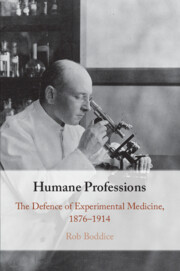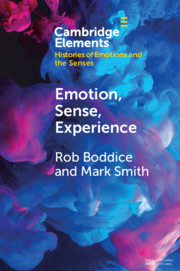23 results
Acknowledgements
-
- Book:
- Humane Professions
- Published online:
- 22 January 2021
- Print publication:
- 28 January 2021, pp ix-x
-
- Chapter
- Export citation
3 - Of Laboratories and Legislatures
-
- Book:
- Humane Professions
- Published online:
- 22 January 2021
- Print publication:
- 28 January 2021, pp 80-102
-
- Chapter
- Export citation
Contents
-
- Book:
- Humane Professions
- Published online:
- 22 January 2021
- Print publication:
- 28 January 2021, pp vii-vii
-
- Chapter
- Export citation
Illustrations
-
- Book:
- Humane Professions
- Published online:
- 22 January 2021
- Print publication:
- 28 January 2021, pp viii-viii
-
- Chapter
- Export citation
Dedication
-
- Book:
- Humane Professions
- Published online:
- 22 January 2021
- Print publication:
- 28 January 2021, pp v-vi
-
- Chapter
- Export citation
Select Bibliography
-
- Book:
- Humane Professions
- Published online:
- 22 January 2021
- Print publication:
- 28 January 2021, pp 186-199
-
- Chapter
- Export citation
Index
-
- Book:
- Humane Professions
- Published online:
- 22 January 2021
- Print publication:
- 28 January 2021, pp 200-204
-
- Chapter
- Export citation
4 - Paget’s Public
-
- Book:
- Humane Professions
- Published online:
- 22 January 2021
- Print publication:
- 28 January 2021, pp 103-137
-
- Chapter
- Export citation
5 - Cannon Fire
-
- Book:
- Humane Professions
- Published online:
- 22 January 2021
- Print publication:
- 28 January 2021, pp 138-174
-
- Chapter
- Export citation
2 - Medical Monsters?
-
- Book:
- Humane Professions
- Published online:
- 22 January 2021
- Print publication:
- 28 January 2021, pp 50-79
-
- Chapter
- Export citation
Copyright page
-
- Book:
- Humane Professions
- Published online:
- 22 January 2021
- Print publication:
- 28 January 2021, pp iv-iv
-
- Chapter
- Export citation
1 - Darwin’s Compromise
-
- Book:
- Humane Professions
- Published online:
- 22 January 2021
- Print publication:
- 28 January 2021, pp 20-49
-
- Chapter
-
- You have access
- HTML
- Export citation
Introduction: Experior
-
- Book:
- Humane Professions
- Published online:
- 22 January 2021
- Print publication:
- 28 January 2021, pp 1-19
-
- Chapter
- Export citation
Epilogue: Humanity and Human Experimentation
-
- Book:
- Humane Professions
- Published online:
- 22 January 2021
- Print publication:
- 28 January 2021, pp 175-185
-
- Chapter
- Export citation

Humane Professions
- The Defence of Experimental Medicine, 1876–1914
-
- Published online:
- 22 January 2021
- Print publication:
- 28 January 2021
12 - The Cultural Brain as Historical Artifact
- from Part II - Applications
-
-
- Book:
- Culture, Mind, and Brain
- Published online:
- 18 September 2020
- Print publication:
- 24 September 2020, pp 367-374
-
- Chapter
- Export citation

Emotion, Sense, Experience
-
- Published online:
- 18 September 2020
- Print publication:
- 15 October 2020
-
- Element
- Export citation
Susan Lanzoni, Empathy: A History. New Haven, CT and London: Yale University Press, 2018. Pp. ix + 392. ISBN 978-0-3002-2268-5. $30.00 (hardcover). - Cathy Gere, Pain, Pleasure, and the Greater Good: From the Panopticon to the Skinner Box and Beyond. Chicago and London: The University of Chicago Press, 2017. Pp. 282. ISBN 978-0-2265-0185-7. $30.00 (cloth).
-
- Journal:
- The British Journal for the History of Science / Volume 52 / Issue 3 / September 2019
- Published online by Cambridge University Press:
- 27 September 2019, pp. 534-535
- Print publication:
- September 2019
-
- Article
- Export citation
Merridee L. Bailey and Katie Barclay, eds. Emotion, Ritual and Power in Europe, 1200-1920: Family, State and Church, London: Palgrave Macmillan, 2017, pp. xxii+320, £63, ISBN: 978-3-319-44184-9
-
- Journal:
- British Catholic History / Volume 34 / Issue 1 / May 2018
- Published online by Cambridge University Press:
- 24 April 2018, pp. 173-175
- Print publication:
- May 2018
-
- Article
- Export citation
Susan Broomhall (ed.), Spaces for Feeling: Emotions and Sociabilities in Britain, 1650–1850. Abingdon and New York: Routledge, 2015. Pp. 241. ISBN 978-1-138-82817-9. £31.99 (paperback).
-
- Journal:
- The British Journal for the History of Science / Volume 51 / Issue 1 / March 2018
- Published online by Cambridge University Press:
- 07 March 2018, pp. 161-162
- Print publication:
- March 2018
-
- Article
- Export citation

